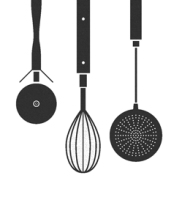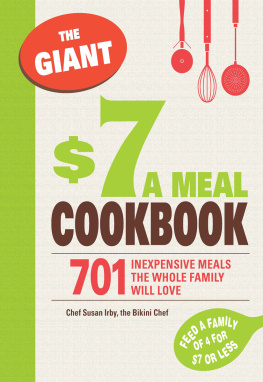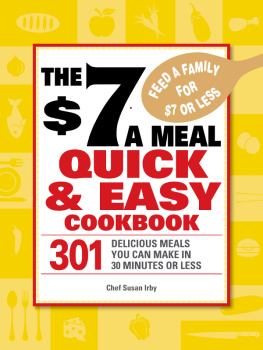THE
GIANT
$ A MEAL
COOKBOOK INEXPENSIVE MEALS
THE WHOLE FAMILY
WILL LOVE
Chef Susan Irby, the Bikini Chef  Copyright 2010 by F+W Media, Inc.
Copyright 2010 by F+W Media, Inc.
All rights reserved.
This book, or parts thereof, may not be reproduced in any form without permission from the publisher; exceptions are made for brief excerpts used in published reviews. Published by
Adams Media, a division of F+W Media, Inc.
57 Littlefield Street, Avon, MA 02322. U.S.A.
www.adamsmedia.com ISBN 10: 1-4405-0635-3
ISBN 13: 978-1-4405-0635-2
eISBN 10: 1-4405-0904-2
eISBN 13: 978-1-4405-0904-9 Contains material adapted and abridged from $5 a Meal College Cookbook, by Rhonda Lauret Parkinson with B. E. Horton, MS, RD, copyright 2010 by F+W Media, Inc., ISBN 10: 1-4405-0208-0, ISBN 13: 978-1-4405-0208-8; The $7 a Meal Cookbook, by Linda Larsen, copyright 2009 by F+W Media, Inc., ISBN 10:1-60550-109-3, ISBN 13: 978-1-60550-109-3; The $7 a Meal Healthy Cookbook, by Chef Susan Irby, copyright 2009 by F+W Media, Inc., ISBN 10: 1-4405-0338-9, ISBN 13: 978-1-4405-0338-2; The $7 a Meal Quick & Easy Cookbook, by Chef Susan Irby, copyright 2009 by F+W Media, Inc., ISBN 10: 1-4405-0223-4, ISBN 13: 978-1-4405-0223-1. 10 9 8 7 6 5 4 3 2 1 Library of Congress Cataloging-in-Publication Data
is available from the publisher. 10 9 8 7 6 5 4 3 2 1 Library of Congress Cataloging-in-Publication Data
is available from the publisher.
This publication is designed to provide accurate and authoritative information with regard to the subject matter covered. It is sold with the understanding that the publisher is not engaged in rendering legal, accounting, or other professional advice. If legal advice or other expert assistance is required, the services of a competent professional person should be sought. From a Declaration of Principles jointly adopted by a Committee of the
American Bar Association and a Committee of Publishers and Associations Many of the designations used by manufacturers and sellers to distinguish their product are claimed as trademarks. Where those designations appear in this book and Adams Media was aware of a trademark claim, the designations have been printed with initial capital letters. This book is available at quantity discounts for bulk purchases.
For information, please call 1-800-289-0963.
INTRODUCTION
The price of everything is skyrocketing these days.
Remember when media pundits told us that at least we're not paying $4 a gallon for gasoline like people in England? That's now a reality. Gas prices, commodities futures, and the economy in general are forcing food prices up sharply. We have to take control of our budgets. In this book you'll learn how to shop in a grocery store, plan meals, write lists so you won't run out of food unexpectedly, and make a few meals out of practically nothing. The price in this book has been calculated for the total recipe. Most magazines and books tell you the price per serving, which is accurate, but a recipe that claims to cost $3 per serving is almost $20 to feed six people.
Recent issues of popular magazines offered budget meals with a cost per serving of $2.50 or less which is $10 for four, and a popular fast food restaurant is bragging that you can feed your family for less than $4 a person. These meals are a deal! The number of servings in each recipe is only calculated after the calorie count is known, so you aren't being cheated by 100-calorie-a-serving treats masquerading as meals. To cook successfully on a budget, you must follow a few rules. Making and abiding by a grocery list is one of the most important. Having a list in hand helps reduce temptation and will keep you focused on your goal. When you're busy comparing the prices of two kinds of chopped canned tomatoes, you'll be less likely to think about the freshly made chocolate chip cookies beckoning you from the bakery.
In this book, you'll find tips on how to avoid the traps that grocery store designers set for you. (Look high and low on the shelves because the most expensive products are placed at eye level.) And you'll learn how to get the best value for your money with a little secret called unit pricing. The cost for each recipe was figured using NutriBase Clinical Version 7.0. To get the best representative cost for each ingredient, price lists at SimonDelivers.com, YourGrocery.com, and Peapod.com were used. Sale prices, discounts, and coupons were not included in the calculations, so you may find that prices in your area are higher or lower than those stated here. Every cook is different and so is every kitchen.
These recipes were developed with cost savings in mind. Each recipe has the cost per serving, and many have a note to make the recipe more special and expensive if you want to splurge. Let's cook!
CHAPTER 1
COOKING ON A BUDGET

We used to joke that every time we turned around, prices went up. Now we know it's true! The price of oil, commodities speculation on the stock market, using food for fuel, the growing world population, and changing weather and climate all have an effect on food prices. Studies and surveys show that most of us are abandoning restaurants and fast food places and are trying to cook and eat at home.
IT'S ALL ABOUT THE PLAN
Everything should start with a plan, whether you're making a household budget, searching for a job, or trying to feed your family on less money.
IT'S ALL ABOUT THE PLAN
Everything should start with a plan, whether you're making a household budget, searching for a job, or trying to feed your family on less money.
If you write lists, plan menus, and cut coupons you will save a significant amount of money, and you will be able to serve your family tastier and more nutritious food. Cook at Home Here's the most important rule: You will save money if you cook at home rather than spend your money in restaurants. The more work you do, and the simpler, more basic foods you buy, the more money you will save. This may sound daunting, but once you get into the habit of cooking it will take you less and less time and the skill will become second nature. Choose to make your own meals and you will control what's in the food you feed your family. Eating lower on the food chain doesn't just mean avoiding beef, pork, and chicken.
It also means eating foods that are as close to harvest condition as possible. A ripe peach will be less expensive than ice cream made with peaches or a bottled peach salsa. Manufactured foods will almost always cost more than the raw ingredients assembled by you. Then begin by planning. Plan every meal. Plan for snacks and for the occasional evening out.
Plan to use leftovers, and budget for special occasions. This may feel rigid, but you will realize that when you have meals planned for the week, you'll have more time for other things. The food you need will be in the house, you know what you'll prepare every day, and you won't have to spend time thinking about how you're going to get breakfast, lunch, and dinner on the table. What's Cheaper? A lot of your grocery savings will depend on what you buy. It's important to know that buying whole chicken breasts and deboning them yourself will not only cost less, but give you more for your money. The bones and skin can be saved to make chicken stock.
In fact, for all of the recipes in this book I recommend buying bone-in, skin-on chicken breasts and removing the large breast muscle yourself. If you do this, a boneless, skinless chicken breast will cost you about a dollar. Buying them already boned and skinned will cost almost $2.00 apiece. Surprisingly, butter costs about 10 cents a tablespoon, while the least expensive form of olive oil is 20 cents per tablespoon. When you're frying foods and want the best taste, butter and olive oil are the best choices. Use butter for the best flavor, and add a bit of the more expensive olive oil to raise the smoke point and keep the butter from burning.











 Copyright 2010 by F+W Media, Inc.
Copyright 2010 by F+W Media, Inc. We used to joke that every time we turned around, prices went up. Now we know it's true! The price of oil, commodities speculation on the stock market, using food for fuel, the growing world population, and changing weather and climate all have an effect on food prices. Studies and surveys show that most of us are abandoning restaurants and fast food places and are trying to cook and eat at home.
We used to joke that every time we turned around, prices went up. Now we know it's true! The price of oil, commodities speculation on the stock market, using food for fuel, the growing world population, and changing weather and climate all have an effect on food prices. Studies and surveys show that most of us are abandoning restaurants and fast food places and are trying to cook and eat at home.